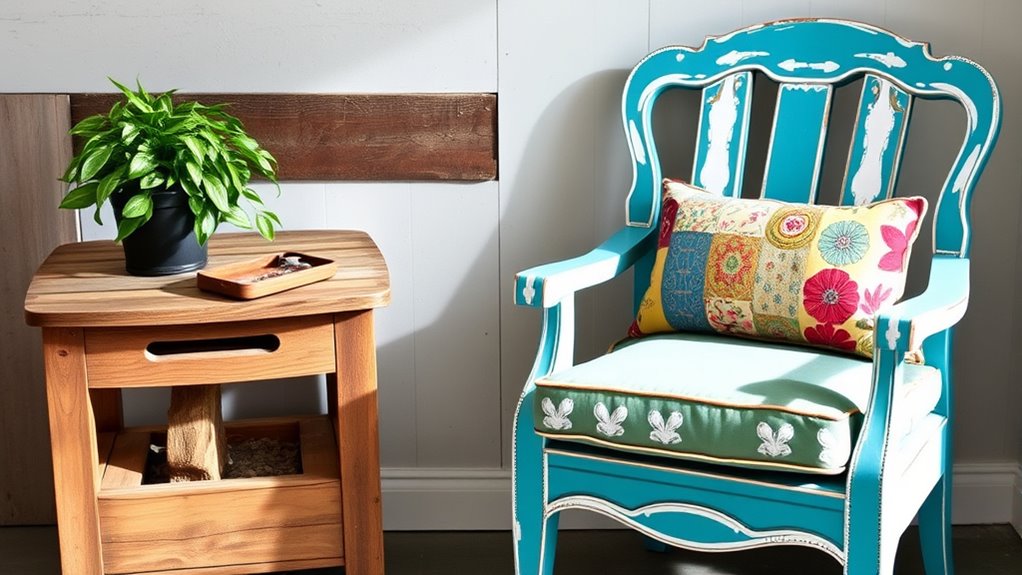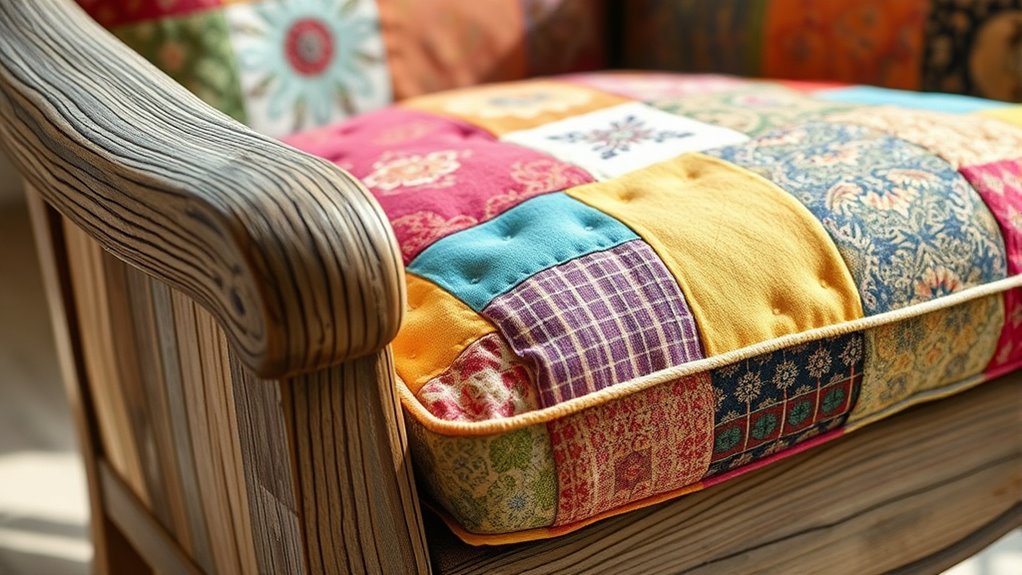Upcycling furniture lets you give old pieces a fresh, personalized look while reducing waste and supporting eco-friendly practices. Start by selecting sturdy items like worn chairs or dressers, then use simple techniques like sanding, painting, or hardware updates to transform them. Incorporate sustainable materials and creative finishes to match your style. This process not only creates unique decor but also shows your commitment to sustainability. Keep exploring to discover easy tips and inspiring ideas for your upcycling projects.
Key Takeaways
- Select sturdy, worn furniture pieces suitable for upcycling with potential for a fresh, personalized look.
- Use simple DIY techniques like sanding, painting, or hardware updates to transform old furniture.
- Incorporate eco-friendly paints and sustainable materials to enhance environmental benefits.
- Add decorative elements such as stencils, decals, or wallpaper for unique, personalized finishes.
- Upcycling reduces waste, saves money, and creates one-of-a-kind furniture that reflects individual style.

Upcycling furniture is a creative way to breathe new life into old or worn pieces while reducing waste. When you choose to upcycle, you’re engaging in sustainable craftsmanship that benefits both your space and the environment. Instead of discarding furniture, you transform it into something unique and personal, showcasing your style while making eco-conscious choices. This approach not only saves money but also reduces the demand for new resources, making your decorating efforts more sustainable.
Getting started with upcycling furniture is easier than you might think. You can begin by selecting a piece that has good bones but needs a fresh look, such as an outdated dresser or a tired wooden chair. The key is to see potential where others might see only wear and tear. Once you’ve picked the right piece, you can plunge into DIY decorating techniques that suit your skill level and aesthetic preferences. Sanding, painting, staining, or adding new hardware are simple yet effective ways to refresh furniture. These techniques allow you to customize pieces to match your home’s decor, whether you favor rustic charm or modern minimalism.
Using DIY decorating techniques also offers an opportunity to experiment with different finishes and textures. For example, distressing paint can give furniture a vintage look, while a sleek coat of high-gloss paint can bring a contemporary vibe. Adding stencils or decals can incorporate patterns or motifs that reflect your personality. If you’re feeling more adventurous, decoupage or wallpapering a surface can add visual interest and depth. These techniques not only make the piece stand out but also make the process enjoyable and rewarding.
As you upcycle, consider the materials you use. Opt for eco-friendly paints, stains, and sealants that minimize environmental impact. Choosing sustainable materials aligns with your goal of sustainable craftsmanship and ensures your project remains eco-conscious from start to finish. Plus, upcycling can be a great way to incorporate recycled or repurposed elements, such as using old fabric for upholstery or reclaimed wood for shelving. Recognizing the importance of color accuracy in project finishes can help you achieve a more polished and professional look.
In the end, upcycling furniture is about more than just beautifying your home. It’s a conscious choice to reduce waste, embrace creativity, and develop your skills in DIY decorating techniques. Every piece you breathe new life into becomes a testament to your commitment to sustainability and craftsmanship. With a little effort, patience, and imagination, you turn old furniture into cherished, one-of-a-kind pieces that reflect your style and values.
Frequently Asked Questions
What Tools Are Essential for Furniture Upcycling?
When you’re tackling furniture upcycling, vital tools include a good sander to master sanding techniques, ensuring a smooth surface. You’ll also need screwdrivers and pliers for hardware selection and replacement. A variety of brushes and paint or stain for finishing work are essential. Don’t forget protective gear like masks and gloves to keep safe. These tools make it easier to transform old pieces into stunning, refreshed furniture.
How Do I Choose the Right Paint or Finish?
When choosing the right paint or finish, focus on paint selection and finish types that suit your project. Consider the furniture’s use and the environment—use durable, water-based paints for high-traffic pieces. Matte or satin finishes work well for a vintage look, while glossy finishes add shine. Test small areas first to see how the paint interacts with your piece, ensuring you get the perfect look and durability.
Can Upcycling Furniture Be a Profitable Business?
You might worry that upcycling furniture isn’t profitable, but market trends show increasing demand for unique, eco-friendly pieces. By understanding customer preferences, you can target niche markets and set competitive prices. With creativity and smart sourcing, you can turn old furniture into desirable items, making upcycling a lucrative business. Staying current with trends and listening to customer needs helps you build a sustainable, profitable venture in this growing industry.
How Do I Repair Damaged or Broken Furniture Pieces?
When repairing damaged furniture, start by evaluating the damage. Use wood glue for cracks or broken joints, ensuring you apply it evenly and press with furniture clamps to hold the pieces together securely while drying. For broken parts, replace or reinforce as needed. Sand the repaired area smoothly afterward. This hands-on approach helps restore furniture’s strength and appearance, making it ready for upcycling or continued use.
What Safety Precautions Should I Take During Upcycling?
When upcycling furniture, you should prioritize safety by wearing appropriate safety gear like gloves, goggles, and a mask to protect against dust, fumes, and splinters. Guarantee proper ventilation precautions are in place, such as working in a well-ventilated area or using fans, to avoid inhaling harmful fumes from paint or chemicals. Stay alert, follow product instructions, and keep your workspace organized to prevent accidents.
Conclusion
So, next time you see that battered old chair or drab dresser, remember—you’re not just saving money, you’re saving the planet from boring, landfill-bound furniture. Who knew giving new life to old pieces could be so revolutionary? With a little paint and a dash of imagination, you’re basically a hero in disguise, turning trash into treasure. Because really, why settle for generic when you can upcycle and make your home uniquely “you”?








